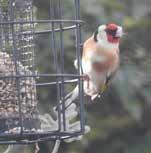






























































Dear Readers,
“Should auld acquaintance be forgot and never brought to mind? Should auld acquaintance be forgot and auld lang syne?”
If you didn’t sing this whilst smashing a prosecco with Jools Holland on the tellybox – how do you even know it is New Year!?
I’m embracing the year of the Rabbit and going for a year of hope! With that in mind, I’d thought I’d have a bit of fun and make some predictions for 2023 –channelling my inner Nostradamus.
• We will have fewer Prime Ministers than in 2022
• Everyone will own an Oodie as a replacement for our central heating



• Elon Musk will propose a duel to Mark Zuckerberg for Facebook & the whole of the Metaverse
• David Beckham (the National Labrador) will join another queue and he will finally be granted his longsolicited Knighthood
• Donald Trump has a DNA test and it is discovered that whilst he is a descendent of an actual orange from Spain his hair is in fact actually one of those really furry caterpillars. And yet he is still on the Republican ballot for POTUS nominees
• Having had the coldest winter on record, we follow the summer with the hottest year on record again and Britain went into meltdown – literally.
• These seasonal record temps are attributed to global warming and, after the success of the covid rules, the govt panic and introduce a national mandate for ‘us’ (not ‘them’) to stop travelling, stop eating Beef specifically and trying to only breathe outwards on every other breath.
• Kanye West moves to Qatar to “become at one with his personal values”
Just a few of my thoughts for this coming year. If you have a mind to, send me over some of your predictions for next year. Only tongue in cheeks ones though –our inbox now has a filter that removes emails that sound too grumpy!!!!
Anyhoo, I’m off to drown my sorrows as 2023 brings a most unwelcome birthday – no dry January for me!!
Raising a glass to you all for a most wonderful 2023,
I am, of course, referring to Chinese Zodiac signs and their twelve-year cycle.

This year the Chinese New Year is 22 January, and we are moving into the “year of the rabbit” … actually, the full title is Year of the Water Rabbit, as Chinese astrology is based on five elements - Metal, Wood, Water, Fire, and Earth - as well as the twelve animal signs.
The sign of Rabbit is a symbol of longevity, peace, and prosperity in Chinese culture and 2023 is predicted to be a year of hope (not before time!).

Yours truly was born in the Year of the Water Rabbit several decades ago, so I was hoping that the predictions would say 2023 is going to be a banger of a year for me.
Sadly, even though “people born in the year of the Water Rabbit year are predicted to enjoy good fortune and have a peaceful mind throughout their lives”, I also spotted a warning, “you are predicted many challenges with frequent life changes. You’re advised to be more careful about all aspects of your lives in 2023.”
Ho hum…another year of upheaval on the cards then?!
The web page with that slightly confusing information for us rabbits, did suggest a way to mitigate the less pleasant possibilities of 2023 - namely, to “wear red underwear and carry or wear lucky dog trinkets”!








That’s me off to M&S for some sale price red undies then, although I’m not sure they stock “lucky dog trinkets” …I’m not even sure what they are.
Some other things said to bring good luck to us rabbits are…
• Lucky numbers: 3, 4, 6, and numbers containing them (like 34 and 46)






• Lucky colours: red, pink, purple, blue





• Lucky flowers: plantain lily, jasmine
• Lucky directions: east, south and northwest
• Of course, there are also some unlucky things (everything in balance, eh?)
• Unlucky numbers: 1, 7, and 8
• Unlucky colours: dark brown, dark yellow, white




• Unlucky directions: north, west, and southwest
I have to admit to being more than a little confused by some of this “advice”, particularly the directions. If northwest is lucky…how can north and west be unlucky?
Fortunately, I like lilies and jasmine and can deal with red, purple and blue (though not fond of pink) so maybe I’ll have to surround myself with flowers and start dressing in more flamboyant colours to keep my luck alive in 2023.
These articles are researched and written by Laura Billingham, a local content writer and author. Laura moved to the Peak District several years ago to pursue her passion for writing. To find out more visit www.landgassociates.co.uk or contact Laura on 07736 351 341
Don’t forget to mention Voice Magazines when responding to the Ads

Are you a rat, ox, monkey, goat, or pig…?
Do you even know what I’m talking about?























As many of us struggle to manage the cost of fuel bills this winter, my mind is cast back to winters during my childhood. There was no central heating and bedrooms were not heated. Instead, our beds were covered with layers of blankets acquired from various sources: a grey army blanket, one acquired from a hospital, a crocheted cover topped off with an eiderdown. If it was especially cold, a warm coat would be laid over the top. Typically, only one fire in the house was lit in the living room.





In the mornings after Dad had gone to work, mum would bring us downstairs and huddle us on the settee, covered with a blanket while she lit the fire. There we would watch as she rolled up lengths of newspaper into either a baton or a doughnut shape and use that atop a firelighter. The kindling went on next and, once that was alight, a couple of pieces of coal. To get it going, she used a sheet of newspaper to draw the fire, usually managing to whisk it away before it caught light, but not always.




The fireguard was always securely fixed in place through which we could still watch the dancing of the orange flames. Coal would be delivered by flat-bed lorry and the coal men, blackened and bent, carrying huge heavy sacks of coal to each house and depositing it either in the coal cellar or the coal bunker. It was free if your dad worked in the colliery. Nowadays we have storage heaters and a wonderful small log-burner called a “Hobbit”


Smoky pork and pepper casserole with carrot and parsnip mash

Method
1. Start by making the mash. Bring a saucepan of water to the boil over a high heat and cook the carrots and parsnips for 20 minutes or until tender.
2. Meanwhile, spray a large nonstick casserole pan or frying pan with low-calorie cooking spray and place over a high heat. Add the pork, peppers and onion and season lightly. Cook for 5 minutes or until the meat begins to brown, then cover, turn the heat down a little and cook for a further 10 minutes.
3. At the same time, cook the barbecue sauce according to the pack instructions.
This recipe will have you licking your lips and probably the plate afterwards! Warming, filling and really tasty. Yes please!
Ingredients:
4. Add the barbecue sauce to the pork along with 300ml boiling water, cover and simmer gently for 5 minutes or until the meat is cooked and tender.
5. Drain the carrot and parsnips, reserving 6 tbsp cooking water, and return to the pan. Mash the carrots and parsnips with the reserved cooking water and season with plenty of freshly ground black pepper and a little salt.
6. Divide the mash between plates or bowls and top with the pork casserole. Scatter over the parsley and serve hot with Speed vegetables.
Serves: 4 Ready in: 35 mins
Low-calorie cooking spray
600g lean pork tenderloin, visible fat removed, cut into chunks
2 large red peppers, deseeded and cut into chunks
1 large red onion, cut into chunks
350g pot Slimming World Barbecue Sauce
Chopped fresh parsley, to serve
For the mash: 400g carrots, roughly chopped 750g parsnips, peeled and roughly chopped
Syns per serving: FREE



























Everyone may recall a previous article I wrote about the WLA. Many assume that it started in WW2 but indeed has roots in WW1 and even earlier. Most people associate Lady Denman with the Women’s Institute and later the WLA. However, Louisa “Lill” Jebb Wilkins (August 8, 1873 - 1929) was the first woman Univ. of Cambridge Agriculture Graduate in 1897, to actually hold the helm of the WW1 WLA.



She was an agricultural administrator and was born on 8 August 1873 at The Lythe, Ellesmere, Shropshire. The daughter of Arthur Trevor Jebb (1839–1894), barrister, and Eglantyne Louisa Jebb (1845–1925). She was one of six children, four girls and two boys and hers was a traditional land-owning family. A family with a devout Christian belief and sense of public duty, their father believed that ‘of those to whom much is given, much is expected’, and was strongly of the opinion that his four daughters should be educated at home to a certain level. However, Arthur’s sister, Louisa, (known as ‘Aunt Bun’, whilst her niece Louisa was known as ‘Lill’ within the family to distinguish them from each other) thought otherwise, and paid for all four girls to receive further education, as she had done, being one of the first women to attend the newly-founded Newnham College at Cambridge University. Lill also went to Newnham and became the first woman to read for the Agriculture Diploma at Cambridge, which inspired her interest in agriculture and eventually led to her founding the Women’s Land Army during the First World War and also helping to develop the Women’s Institute movement. She was founder member of the Women’s Farm and Garden Union in 1899. For three years up to 1907 she was retained by the Cooperative Small Holdings Association. 1907 saw her publish ‘The Small Holdings of England’ which was an attempt to provide a survey of the small holdings of England.
In February 1916, the Women’s Farm and Garden Union sent a deputation to meet Lord Selbourne to establish a group in response to the war effort. Under the Ministry of
Agriculture, the Women’s National Land Service Corps was born with a pot of funding of £150! Wilkins was to lead the new voluntary organisation that was to focus on recruiting women for emergency agricultural war work. She chaired the executive committee, offices were established in Upper Baker Street and the 9th Duke of Marlborough agreed to be president.
The new organisation was tasked with improving recruitment and providing propaganda about the benefits of women of all classes undertaking agricultural work. The new members of her organisation were not to become agricultural workers but to organise others (e.g., in villages) to do this work. By the end of 1916 they had recruited 2,000 volunteers, but they estimated that 40,000 were required.
At the Women’s National Land Service Corp’s suggestion a Land Army was formed. The WNLSC continued to deal with recruitment and the network supported the launch of a “Land Army”. By April 1917 they had over 500 replies and 88 joined the new Land Army where they became group leaders and supervisors. As more men were required at the front, so too were more women to replace those gone off to war. The organisation grew to 23,000 women earning about a pound a week. This was a sizeable contribution but it is estimated that the number of women working on the land during the war eventually reached around 300,000. Lill’s sisters, Eglantyne and Dorothy Jebb, went to Oxford and Cambridge respectively, and at the end of the First World War in 1919 co-founded the Save the Children Fund.














Are you for it? Against it?
Haven’t got a clue what I’m talking about?
For those that aren’t aware, Dry January is a month-long challenge established by Alcohol Change UK where you commit to not drinking alcohol. The very first one of these was in 2013, so relatively speaking it is a newish annual event.
In January 2022, over 130,000 people signed up to take part in the challenge via email or a phone app and many more probably joined in on a more ad hoc basis.
There is ample evidence that staying off the booze is great for your physical and mental health. Benefits such as losing weight, improved concentration, and sleep patterns, as well as the positive impact on blood sugar levels, blood pressure and the liver, are cited.

Past participants have also reported that they are still drinking less six months after the challenge and can definitely feel an overall improvement in their health and wellbeing.
Going alcohol free for 31 days in January aims to re-educate us to accept that we don’t have to drink to have a good time. And, of course, scheduling the challenge for the New Year after the boozy excesses of Christmas, ties in wonderfully well with our annual “must-do better resolutions”!
There is though another side to this story… the small breweries, distilleries, and pubs that see a drop in their revenues during this time. With everything else that’s gone on over the past
few years, it would be fair to say that most of those businesses are not fans of Dry January. Interestingly, since the inception of Dry January, major pub chains have started to stock more alcohol-free beers, obviously trying to recoup some lost income.
Drinking alcohol is very much a part of British culture. Having a pint in the pub, a bottle of wine over dinner, or a G&T in the garden is so normalised that most of us don’t see it as anything unusual or untoward.
However, alcohol IS a drug, and like all drugs, it can be addictive for some individuals. We wouldn’t condone someone snorting cocaine, shooting heroin, or sniffing aerosols for kicks, and yet getting completely mullered on a regular basis is seen as “normal.”
According to Alcohol Change UK, one person every hour dies in the UK as a result of alcohol… that is a scary statistic, isn’t it? It’s also not one to take any pride in!
I enjoy a drink or three, and will continue to do so, even in Dry January; however, I am much more aware of my limits these days. Whether this knowledge was sparked by the idea of an alcohol-free month or simply by the realisation that I actually don’t enjoy the after-effects of alcohol as much as the drinking is a moot point.
If you drink, do so sensibly.
If you want to do Dry January - go for it!
These articles are researched and written by Laura Billingham, a local content writer and author. Laura moved to the Peak District several years ago to pursue her passion for writing. To find out more visit www.landgassociates.co.uk or contact Laura on 07736 351 341


































The Dressmaker’s Gift by Fiona Valpy is a potent and absorbing tale to counter these cold and dark winter days.
It’s set in France, mostly Paris, during the Second World War and focusses on three young women who produce dresses for the high end of the haute couture market. - It may have been the middle of a war but there was still a market for posh frocks, not least among the wives and mistresses of the Nazi occupiers.
And while, with hindsight, we understand what was happening during that period, it may not always have been so obvious to impressionable young people at the time and one of the girls becomes involved with a German officer.

At the same time the resistance is growing and inevitably the girls become caught up in that – and suffer the consequences in the worst ways. Interwoven with this is the story of a young woman in our present day who is trying to uncover her family’s history.
It’s well researched historically and is interesting on the complexities of living in historic times. But it’s also full of heart and the strong relationships of these women in the face of almost daily terror makes it an uplifting story.































Colder weather has brought lots of small birds into wildlife garden across the region. From a period of marked quiet in October and November, December saw a big increase with blue tits, great tits, coal tits and long-tailed tits in abundance. The robins and dunnocks remained throughout, and they are territorial in winter as well as summer, they even manage to sing a little too. Blackbirds have also returned to the garden with local birds back from foraging in hedgerows and woodlands across the area joined by migrants from Europe. The local birds are quite aggressively territorial and object strongly to intruders, the continental birds perhaps having travelled together for hundreds of miles, seem happy to flock. The locals take a dim view!
Finches have also arrived in good numbers with chaffinches, greenfinches (now seemingly recovering from the devastating ‘fat finch disease’), goldfinches, and bullfinches. The smaller siskin and redpoll are also in flocks across the Peak District and nearby areas and will come to gardens as the winter draws on. Feeders of peanuts, fat-balls, and sunflower seeds provide a mix of food sources to suit all tastes, but interestingly, whereas at one time niger seed were guaranteed tract goldfinches, they are now totally ignored. Instead, the goldfinches only take sunflower hearts, which a of course are the most expensive too! Dried mealworms are good for the robins although, being short-lived, my favourite birds which used to come down and ‘talk’ to me, I think has passed on. I am now trying to gain the trust of a new bird.
Along with the smaller birds, my great spotted woodpeckers, male and female, are now regular visitors. I have heard nuthatches calling nearby but not seen them in the garden so far. Overhead, small groups of black-headed gulls and lesser black-backed gulls are now regular as are flocks of woodpigeons moving through. There don’t yet seem to be any big flocks of the corvids (crows) heading to afternoon roosts, but perhaps that will come with colder conditions. Several big flocks of pink-footed geese passed over and were heading south-east in late November. By February and March, these birds will be on their return migration heading north-west across the Peak and back to the Arctic via Britain’s west coast. Nature’s annual cycle goes around again and the birds reflect this with some staying put, others moving locally, and then many more covering hundreds if not thousands of miles.


Watching and recording birds in, over, and around the garden provides a remarkable insight into the bigger patterns throughout the seasons. You can also witness how bird behaviour gradually changes and evolves as well. So, the goldfinches abandon one seed to feed preferentially on a different one. Robins and chaffinches for example, have taken to feeding on hanging foods such as seed holders and fat-balls, which they never did before. Even magpies now try to feed on peanut holders, and magpies, carrion crows and jackdaws all feast on the fat-balls. The magpies also chase my robin off the mealworms.
Professor Ian D. Rotherham is a researcher, writer and broadcaster on wildlife and environmental issues. He is contactable on info@hallamec.plus.com and you can follow his website and blog: www.ukeconet.org & https://ianswalkonthewildside.wordpress.com/ and he can be followed on Twitter @IanThewildside
Don’t forget to mention Voice Magazines when responding to the Ads



It’s a kind of fungal infection which weakens the plant and at this time of year hellebores – a winter favourite - are particularly vulnerable to it. As with roses the only answer is to remove any leaves which have black blotches and bin them. (Don’t compost as this will only spread the rot).
Keep deadheading winter pansies to encourage more flowers.
You can prune roses now while they are still dormant. Cut back branches to just above a bud, cutting on a slope to avoid wet lying on the surface.
Cut old sedums back now but watch out for new growth which may be starting to push through.
Top Tip:

You can push bare-root fruit canes into rich soil now, so long as the ground is not frozen.

If you have ivy or other climbers which need pruning, trim them now before birds start nesting in them.

the only plants to get blackspot.






















